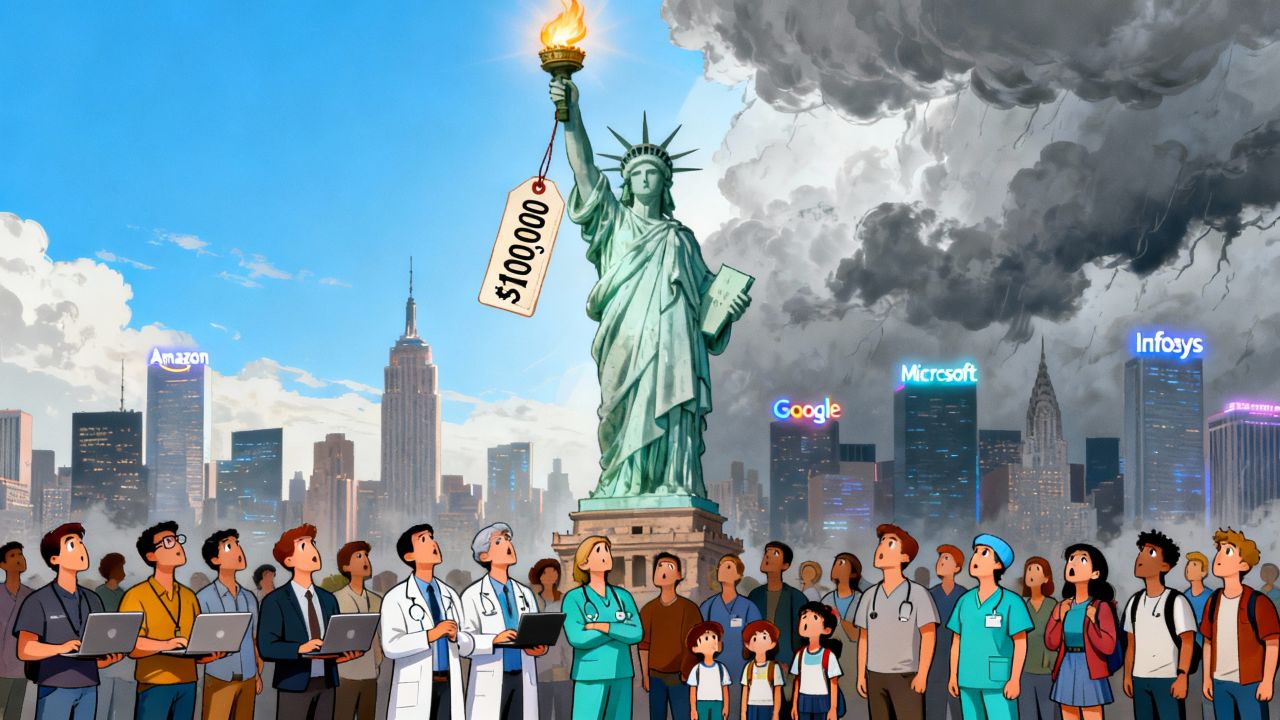
Donald Trump has done it again: blown up decades of immigration precedent with a single proclamation, this time attaching a $100,000 fee to H-1B visas — the skilled worker permits that Silicon Valley, hospitals, and research labs have depended on for years.
The move, announced on September 21, 2025, represents not just a staggering cost increase (current fees range between $2,000 and $5,000), but a reimagining of America’s openness to global talent. Depending on whom you ask, it’s either a righteous corrective to “cheap labor” or the economic equivalent of shooting the U.S. in both feet.
What the Trump Order Actually Does
The proclamation requires employers to pay a $100,000 fee for each new H-1B visa petition. It applies only to new applicants who are outside of the United States. Current visa holders and renewals are exempt — at least for now. After a scramble of contradictory statements from Commerce Secretary Howard Lutnick, who initially floated the idea of an annual fee, the White House clarified that the levy is a one-time charge per petition.
The administration is also ordering the Labor Department to hike prevailing wage standards, meaning that companies hiring H-1B workers will be forced into salary levels intended to prevent undercutting U.S. workers.
What used to be a middle-class employer immigration tool is now something closer to a luxury permit.
Economic Shockwaves
This is not just about immigration. It’s about economics, geopolitics, and control.
Economists estimate the fee could shave U.S. growth rates, as companies start facing dual costs: steep fees plus higher mandated wages. One researcher bluntly called it “anti‑growth policymaking” that risks choking off America’s supply of brainpower in science and technology.
Consider this:
- Amazon, Microsoft, Meta, Apple, and Google rank among the largest recipients of H-1B visas. These firms can afford the cost. But the startups and midsized firms — the scrappy innovation engines — likely cannot. As immigration lawyer Tahmina Watson told the BBC, her small business clients are “going to be priced out”.
- Indian and Chinese tech workers, who make up more than 80% of H-1B approvals, will be the hardest hit. India’s government blasted the move as “disruptive to families,” warning of humanitarian fallout that goes far beyond boardrooms.
- Wall Street is reading the move as yet another unpredictable Trumpian tariff-by-any-other-name. Shares of Indian IT giants Infosys and Tata Consultancy fell about 3% following the news, reflecting how globalized supply chains — and workforce strategies — are suddenly destabilized.
Chaos in Practice, Not Just Policy
The rollout was pure Trump: maximum theater, minimum clarity. On Friday, Silicon Valley staffers got memos urging them not to leave the country, fearing they’d be locked out. Passengers abandoned flights back to India. By Saturday, the White House scrambled to clarify that current H-1B holders abroad wouldn’t be affected.
Even so, the confusion had already inflicted real costs on lives and businesses. Families canceled weddings, vacations, and even funerals abroad. The measure turned overnight into a stress test for immigrant workers’ trust in U.S. institutions.
The Larger Context: Nationalist Economics Disguised as Policy
Trump’s case rests on the argument that H‑1B “abuse” displaces American workers. The White House notes that foreign IT labor has climbed dramatically in the past decade, often concentrated in outsourcing firms that pay below Silicon Valley’s median wages. Commerce Secretary Lutnick called the new fee “commonsense,” pitching it as a way to privilege truly “indispensable” hires.
But the deeper game is political. For his MAGA base, this is about “restoring” control, punishing tech elites, and signaling a crackdown on globalization itself. For businesses, it’s an ultimatum: pay up or look elsewhere. And for international students and foreign workers, it’s a chilling reminder of how fragile even “legal” immigration status can be under nativist governance.
Why This Isn’t Just About Visas
This move should be read alongside Trump’s new proposal for a $1 million “gold card” visa for wealthy immigrants — effectively auctioning off quick immigration pathways to the global elite. When working-class and middle-class skilled migration is taxed out of viability, but billionaire visas are expanded, the contradiction couldn’t be sharper. America is slamming shut one kind of door while carpet‑rolling another.
It’s a statement of values: America first, unless you’re fabulously wealthy. Then, welcome.
Where This Leads
Expect lawsuits. Normally, visa fees are set through Congress or notice-and-comment rulemaking, not sudden executive orders. Immigration experts called Trump’s move “ludicrously lawless” and almost certain to face legal challenges PBS.
But courts take time, and in the meantime, the signal has been sent: the U.S. no longer welcomes the world’s best minds on affordable terms. Canada, the EU, and Australia — long waiting at the door with friendlier policies — will gladly swoop in for the talent America turns away.
If the 20th century was marked by America’s immigrant-driven dynamism, the 21st might mark the slow dismantling of that edge under nationalist populism. Democrats, progressives, and business leaders alike now face a sobering question: how do you sustain innovation without openness?
The H-1B fee hike isn’t just about workers. It’s about the very idea of America as a magnet for global talent — and whether that identity survives Trump’s second presidency.
